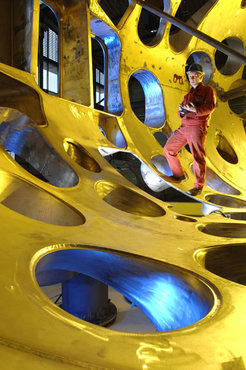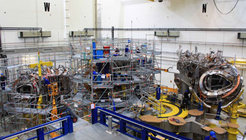Main components for Wendelstein 7-X all ready
Components for outer casing delivered / installation in progress

Once completed, Wendelstein 7-X will be the world’s largest fusion device of the stellarator type. Its objective is to investigate this concept’s suitability for a power plant. The aim of fusion research is to derive energy from fusion of atomic nuclei, this being the same process as occurs in the sun. In order to ignite the fusion fire, the fuel in a future power plant, a hydrogen plasma, has to be confined in magnetic fields and heated to temperatures of over 100 million degrees.
The last two of the ten sections altogether of the outer casing have now been delivered to Greifswald. With these steel sections, each weighing 14 tons, all major components are now ready at IPP. These comprise the 70 more than man-size superconducting magnet coils for producing the magnetic cage to confine the plasma, the huge support structure for keeping the coils in position, the twenty sections of the plasma vessel and its over 200 vessel ports, and finally the ten sections of the outer casing. When assembled, they will form a ring-shaped hose 16 metres in diameter. In its 4.4 metres wide interior this thermally insulating cold box will later enclose the whole coil ring, cooled to low temperature, inside which in turn is the plasma vessel containing the plasma, heated to 100 million degrees.

Prior to final assembly, the individual sections of the stellarator device will first be pre-assembled as five almost structurally identical modules, which will then be joined together in the experiment hall to form a circle. Work is meanwhile proceeding simultaneously on all five modules: the first module is almost complete and is already in its final position on the device’s foundation in the experiment hall. The seam between the two casing halves of the outer vessel has yet to be closed; about 50 ports, which connect the plasma vessel with the outer vessel through the cold coil area, have still to be brazed on. At present, the piping for the low-temperature helium coolant on the second and third modules is being completed, as also are the electrical connections between the superconducting coils. The fourth module is just being assembled from the two halves; the magnet coils are being strung onto the two halves of the plasma vessel of the fifth module.
Once all modules are in place on the foundation, the five major components have to be joined to form a ring. Then come the in-vessel components. Mounted in parallel will be the systems for heating the plasma, the supply facilities for electric power and cooling, the device control system, and the numerous measuring instruments for diagnosing the behaviour of the plasma. If all goes according to plan, Wendelstein 7-X should be operational in about five years.
Isabella Milch

